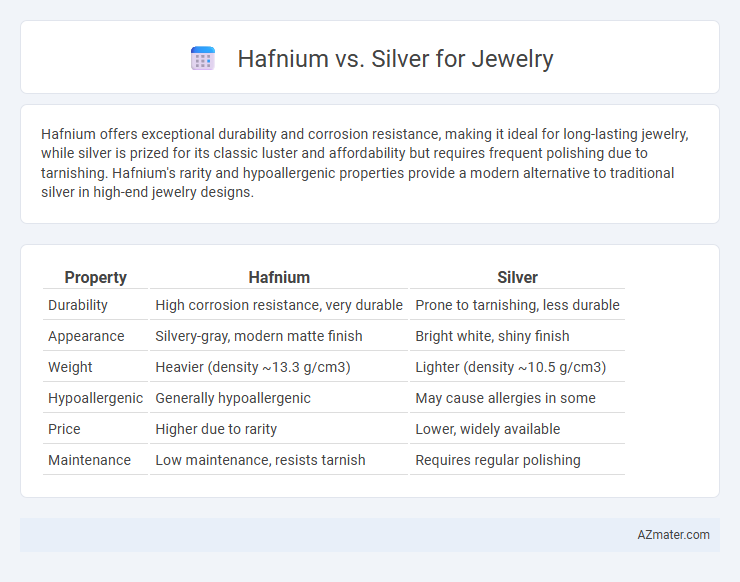Hafnium offers exceptional durability and corrosion resistance, making it ideal for long-lasting jewelry, while silver is prized for its classic luster and affordability but requires frequent polishing due to tarnishing. Hafnium's rarity and hypoallergenic properties provide a modern alternative to traditional silver in high-end jewelry designs.
Table of Comparison
| Property | Hafnium | Silver |
|---|---|---|
| Durability | High corrosion resistance, very durable | Prone to tarnishing, less durable |
| Appearance | Silvery-gray, modern matte finish | Bright white, shiny finish |
| Weight | Heavier (density ~13.3 g/cm3) | Lighter (density ~10.5 g/cm3) |
| Hypoallergenic | Generally hypoallergenic | May cause allergies in some |
| Price | Higher due to rarity | Lower, widely available |
| Maintenance | Low maintenance, resists tarnish | Requires regular polishing |
Introduction to Hafnium and Silver in Jewelry
Hafnium and silver are both valued metals in jewelry, with silver known for its classic luster and affordability, widely used in rings, necklaces, and earrings. Hafnium, a rare transition metal, is prized for its unique metallic sheen, exceptional corrosion resistance, and hypoallergenic properties, making it an emerging choice in contemporary jewelry design. Unlike silver, hafnium offers superior durability and a distinctive grayish-black finish, appealing to those seeking modern, long-lasting pieces.
Physical Properties Comparison: Hafnium vs Silver
Hafnium exhibits exceptional corrosion resistance, high melting point of about 2233degC, and a density of approximately 13.31 g/cm3, making it significantly heavier and more durable compared to silver. Silver has a melting point of 961.8degC and a density of 10.49 g/cm3, with renowned excellent electrical and thermal conductivity but lower hardness and scratch resistance than hafnium. For jewelry, silver offers superior malleability and traditional luster, whereas hafnium's robustness and unique metallic sheen provide enhanced durability and a modern aesthetic.
Durability and Wear Resistance
Hafnium exhibits exceptional durability and wear resistance due to its high melting point of 2,233degC and strong corrosion resistance, making it less prone to scratching and tarnishing compared to silver. Silver, with a lower hardness rating of 2.5-3 on the Mohs scale, tends to scratch easily and requires regular polishing to maintain its luster. Jewelry crafted from hafnium offers superior long-term resilience, especially for everyday wear, while silver's softness can limit its practical durability.
Hypoallergenic Qualities for Sensitive Skin
Hafnium exhibits strong hypoallergenic properties, making it an excellent choice for sensitive skin due to its corrosion resistance and biocompatibility. Silver, while popular in jewelry, often contains alloys like nickel that can trigger allergic reactions in individuals with sensitive skin. Choosing hafnium jewelry reduces the risk of irritation and skin sensitivity compared to traditional silver pieces.
Aesthetic Appeal: Color and Finish
Hafnium jewelry exhibits a unique, lustrous gray to bluish-silver hue with a smooth, reflective finish that offers a modern and subtle elegance. Silver, known for its bright white metallic sheen, provides a classic and highly polished look favored for its timeless appeal and versatility. While silver develops a natural patina over time, enhancing its vintage charm, hafnium maintains a more consistent finish with exceptional resistance to tarnish and corrosion.
Tarnishing and Corrosion Resistance
Hafnium offers superior corrosion resistance compared to silver, making it highly resistant to tarnishing even in harsh environments. Silver, while popular in jewelry, is prone to oxidizing and developing a dark patina due to exposure to air and moisture. Jewelry crafted with hafnium maintains its luster and structural integrity longer, especially in humid or acidic conditions, providing lasting durability.
Maintenance and Care Requirements
Hafnium jewelry requires minimal maintenance due to its natural resistance to corrosion, scratches, and tarnish, making it ideal for daily wear without frequent polishing. Silver, while popular, demands regular cleaning and anti-tarnish treatments to maintain its bright appearance and prevent oxidation. Investing in proper storage and occasional professional polishing is essential for silver jewelry, whereas hafnium's durability significantly reduces long-term care efforts.
Price and Market Value Comparison
Hafnium is significantly rarer and less commercially available than silver, leading to a higher price per gram but limited use in jewelry markets. Silver, widely recognized and traded, maintains a stable market value with affordability and strong demand driving its popularity in jewelry. The comparison shows silver as the more economical and accessible option, while hafnium's niche appeal and scarcity create a higher price point that impacts its market presence.
Popularity and Availability in Jewelry Design
Silver remains one of the most popular metals in jewelry design due to its affordability, bright luster, and widespread availability from numerous suppliers globally. Hafnium, although gaining interest for its unique metallic sheen and hypoallergenic properties, is relatively rare and less accessible, limiting its use mainly to niche or custom pieces. The high availability and versatile appeal of silver ensure its dominance in mainstream jewelry markets compared to the emerging presence of hafnium.
Environmental Impact and Ethical Considerations
Hafnium jewelry offers a lower environmental footprint due to its less intensive mining processes compared to silver, which often involves extensive mining and chemical use that can harm ecosystems. Ethically, hafnium sourcing raises fewer concerns about labor exploitation and conflict resources common in silver mining regions. Choosing hafnium supports a more sustainable and ethically responsible approach to fine jewelry production.

Infographic: Hafnium vs Silver for Jewelry
 azmater.com
azmater.com